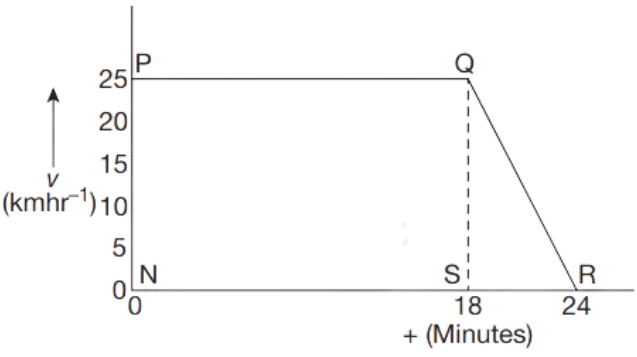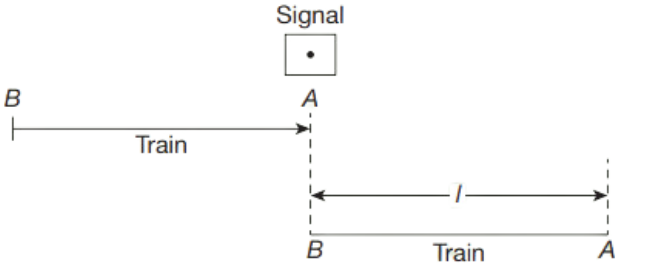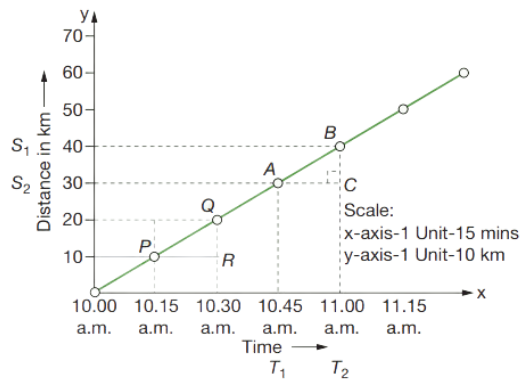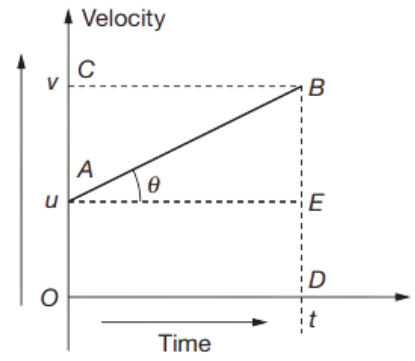Chapter 1 Motion Long Answer Type Question And Answers
Question 1. The given figure shows the velocity-time graph of a bus travelling along a straight road for 24 minutes. Describe its motion. Find
- its retardation
- total distance travelled by the bus

Answer.
Given:
The given figure shows the velocity-time graph of a bus travelling along a straight road for 24 minutes.
(1) Acceleration a = \(\frac{v-u}{t}\)
= \(\frac{(0-25) \mathrm{kmhr}^{-1}}{4 \text { minutes }}\)
= \(-\frac{\left(25 \times \frac{5}{18}\right)}{4 \times 60 \mathrm{~s}} \mathrm{~ms}^{-1}\)
= \(-\frac{125}{18 \times 4 \times 60} \mathrm{~ms}^{-2}\)
= −0.0289 ms-2
∴ Retardation of the bus = 0.0289 ms-2
(2) Total distance travelled = Area of OSQP + Area of ∆QSR
Read and Learn More NEET Foundation Long Answer Questions
= \((N P \times N S)+\frac{1}{2} \times S R \times Q S\)
= \(25 \mathrm{kmhr}^{-1} \times 18 \mathrm{~min}+\frac{1}{2} \times 25 \times 6\)
= \(\begin{aligned}
& \left(25 \times \frac{5}{18}\right) \mathrm{ms}^{-1} \times(18 \times 60) \mathrm{s} \\
& +\frac{1}{2} \times\left(25 \times \frac{5}{18}\right) \mathrm{ms}^{-1} \times 6 \times 60 \mathrm{~s}
\end{aligned}\)
= 25 × 5 × 60 + 25 × 5 × 10
= 7500 + 1250
= 8750 m
Question 2. Barrel of a rifle is 60 cm long. A bullet initially at test, when fired from the rifle, leaves the barrel with a velocity of 300 ms−1. Find
- Acceleration of the bullet
- Time taken by the bullet to emerge from the rifle
Answer.
Given:
Barrel of a rifle is 60 cm long. A bullet initially at test, when fired from the rifle, leaves the barrel with a velocity of 300 ms−1.
Given u = 0
v = 300 ms-1
S = 60 cm = 0.60 m
a = ?
t = ?
(1) ∵ v2 = u2 +2aS
3002 = 0 + 2 × a × 0.6
∴ 1.2 a = 300 × 300
a = \(\frac{300 \times 300}{1.2}\)
= 300 × 250
∴ a = 7.5 × 104 ms-2
(2) ∵ v = u + at
300 = 0 + 7.5 × 104t
∴ 7.5 × 104 t = 300
∴ t = \(\frac{300}{7.5 \times 10^4}\)
∴ t = 4 × 10-3 s
Question 3. When a truck was travelling on a horizontal road with 72 km/hr, its brakes failed. It is found that the truck comes to a complete halt after travelling 100 m on the road. How much retardation is produced in the truck by the road friction?
Answer.
Given:
When a truck was travelling on a horizontal road with 72 km/hr, its brakes failed. It is found that the truck comes to a complete halt after travelling 100 m on the road.
Given u = 72 km/hr-1
= 72 × \(\frac{5}{18} \mathrm{~ms}^{-1}\)
= 20 ms-1
v = 0
S = 100 m
a = ?
∵ v2 = u2 +2aS
0 = (20)2 + 2 × a × 100
∴ 200 a = −400
∴ a = −2 ms-2
∴ Retardation of the truck = 2 ms-2
Question 4. In a cathode ray tube, an electron travels from rest from cathode to anode, a distance of 50 cm. When it reaches the anode, it has a velocity of 3 × 107 ms-1. Find
- Acceleration of the electron
- Time it takes to reach the anode.
Answer.
Given:
In a cathode ray tube, an electron travels from rest from cathode to anode, a distance of 50 cm.
Given u = 0
v = 3 × 107 ms-1
S = 50 cm = 0.50 m
a = ?
t = ?
(1) ∵ v2 = u2 + 2aS
(3 × 107)2 = 0 + 2 × a × 0.5
9 × 1014 = a
∴ a = 0.9 × 1015 ms-2
(2) ∵ v = u + at
v = at (∵ u = 0)
∴ t = \(\frac{v}{a}=\frac{3 \times 10^7}{9 \times 10^{14}}=0.33 \times 10^{-7} \mathrm{~s}\)
Question 5. A train 150 m long is running with a constant speed of 54 km/hr. How long will it take to cross
- a signal?
- a platform 300 m long?
Answer.
Given:
A train 150 m long is running with a constant speed of 54 km/hr.
Speed of the train = 54 km/hr-1
= 54 × \(\frac{5}{18}\)
= 15 ms-1
(1) To cross a signal means to travel a distance equal to its length.

∵ Time = \(\frac{\text { Distance }}{\text { Speed }}=\frac{l}{v}=\frac{150 \mathrm{~m}}{15 \mathrm{~ms}^{-1}}=10 \mathrm{~s}\)
(2) To cross a platform the train has to cover a
distance = L + l = 300 m + 150 m
= 450 m
∵ Time = \(\frac{S}{v}=\frac{450 \mathrm{~m}}{15 \mathrm{~ms}^{-1}}=30 \mathrm{~s}\)
Question 6. An express train (E) and a goods train (G) are travelling with constant speeds of 45 ms-1 and 15 ms-1 respectively. By mistake, they were on same track and approaching each other. When they were 500 m apart, drivers of both the trains realise the mistake and immediately applied brakes to produce retardation of 3 ms-2 and 2 ms-2 respectively. Will they be able to avert accident?
Answer.
Given:
An express train (E) and a goods train (G) are travelling with constant speeds of 45 ms-1 and 15 ms-1 respectively. By mistake, they were on same track and approaching each other. When they were 500 m apart, drivers of both the trains realise the mistake and immediately applied brakes to produce retardation of 3 ms-2 and 2 ms-2 respectively.
Distance S1 travelled by express train before coming to rest can be found out using:
v2 = u2 +2as
0 = (45)2 + 2(−3)S1
6 S1 = 2025
∴ \(S_1=\frac{2025}{6}=337.5 \mathrm{~m} .\)
Similarly distance travelled by goods train before coming to rest is given by
v2 = u2 +2as
⇒ 0 = 152 + 2(−2)S2
⇒ 4 S2 = 225
∴ S2 = 56.25 m
Total distance travelled by them before coming to rest S = S1 + S2 = 337.5 m + 56.25 m
= 393.75 m
Since they were initially 500 m apart, there are still (500 − 393.25) m = 106.25 m apart.
So, there is no accident.
Question 7. Elaborate distance–time graph with a diagram.
Answer.
Distance–time graph with a diagram:

In order to calculate the velocity, consider points A and B on the diagonal line. S1 and S2 are the points on y-axis where A and B points touch horizontally. T1 and T2 are the points on x-axis where A and B touch vertically.
Distance = BC
= S2 – S1
Time = AC
= T2 – T1
\(\text { Slope }=\frac{\text { Change in } y \text { axis }}{\text { Change in } x \text { axis }}\)AB = \(\frac{B C}{A C}\)
v = \(\frac{\left(S_2-S_1\right)}{\left(T_2-T_1\right)}\)
Where v = velocity
(S2 – S1) = Interval of distance
(T2 – T1) = Interval of time
Therefore, Velocity = \(\frac{\text { Distance }}{\text { Time }}\)
Question 8. Deduce the equation for
- Velocity – Time relation
- Position – Time relation
- Position – Velocity relation
Answer.
For the object moving with a uniform acceleration, the following three equations give the relationship between initial velocity (v), acceleration (a), time of journey (t) and distance travelled (S).

(1) Equation for Velocity-Time relation:
Consider the above figure: The initial velocity of an object is u which gradually increases to v in time t. The graph shows uniform velocity.
Initial velocity (at t = 0) = OA = u
Final velocity (at t = t) = OC = v
Acceleration a = Slope of the line AB
a = EB/AE
= AC/OD
= (OC – OA)/OD
= (v – u)/t
at = v – u
v = u + at
(2) Equation for Position–Time Relation:
Consider the above figure:
Distance S travelled in time t = Area of trapezium OABD
= Area of rectangle OAED + Area of triangle ABE
= \(O A \times O D+\frac{1}{2} \times B E \times A E\)
= \(u \times t+\frac{1}{2} \times(v-u) \times t\)
As we know
v – u = at
Therefore,
S = \(u t+\frac{1}{2} a t^2\)
(3) Equation for Position-Velocity Relation:
Consider the above figure:
Distance S travelled in time t = Area of trapezium OABD
= \(\frac{1}{2}(O A+D B) \times O D\)
= \(\frac{1}{2}(u+v) \times t\)
As we know
t = (v – u)/a
Therefore,
S = \(\frac{1}{2}(u+v)\left(\frac{v-u}{a}\right)\)
= \(\frac{1}{2}\left(\frac{v^2-u^2}{a}\right)\)
2aS = v2 – u2
v2 = u2+ 2aS
Question 9. The distance between the house and the school of a girl is 3.6 km. If she takes 6 minutes to reach then her school by car, calculate her speed in m/s. Also express her speed in km/h.
Answer.
Given:
The distance between the house and the school of a girl is 3.6 km.
Distance, S = 3.6 km = 3.6 × 103m
Time, t = 6 min = 6 × 60 = 360 s = 6/60 h
Speed, v = ?
Using formula
v = S/t
v = 3.6/6/60
v = 3.6 × 60/6
v = 36 km/h
Also,
v = 3.6 × 103/360
v = 10 m/s

